Considering Careers Outside Academia? Find Out What a UX Researcher Actually Does
Lindsay Stevens completed a PhD in Sociology at Rutgers University in 2018 and a Postdoctoral fellowship at Princeton University in 2020. She is currently a User Experience Researcher at Capital One.
A little over a year ago, at a time when I was considering broadening my job search beyond academia, I learned that the field of User Experience research existed. More, I learned that I, as a PhD-level sociologist, could be considered a highly qualified applicant for it. What I did not understand was what a User Experience (UX) researcher actually did. That remained a bit of a mystery to me, even as I immersed myself in applying for jobs in the field. Now that I’ve been a UX researcher at Capital One Bank for the past 7 months, I can share what my day-to-day work looks like for social scientists who are considering a similar path.
I work with a group of UX designers, who create new experiences for the bank. Some of those are customer-facing experiences, like a new ATM feature. Others are for Capital One internal employees, like a modernized software system for tellers. Before designers release these new experiences they test them, and that’s where I come in. Are our customers interested in the new ATM feature? Does it meet an actual need of theirs or will it be an annoying distraction? Is it confusing to use? Are they going to try to use it in ways that are different than we anticipated? Answering these questions requires systematic research: interviewing or surveying users about their needs or getting them to try out the feature and carefully watching where they struggle and what they find intuitive. It also requires an understanding how to synthesize data, draw conclusions from it, and understand its limitations.
Other projects I work on are broader than a single feature and also more sociological. For example, I am currently co-leading a project to understand how banks can better serve those populations that have been historically underserved by the financial industry.
Most of my work is qualitative, as it was in my PhD, but my foundational understanding of survey design, sampling, and interpreting quantitative data come in handy all the time. My teammates turn to me when they want to interpret survey results or to know whether an increase in customer service calls is significant or not. (Similar to academia, UX research jobs vary from primarily quantitative to mixed methods to primarily qualitative).
If you are considering applying to UX research jobs, I highly recommend: 1) taking a few courses on User Experience design that are offered by platforms like LinkedIn Learning and Coursera — you may even have free access through your current academic institution, 2) spending some time converting your CV into a resume (Tip: It’s much shorter and focuses on skills and results), and 3) talking to as many people as possible who’ve made the transition before.
Of course, there were about a million things I needed to learn once I started my current job: What’s a product manager? What is human-centered design? How do banks actually make money? How do I decode all of the corporate jargon that sometimes feels more inscrutable than academic jargon? But as my boss said when she hired me, PhDs have already proven they can learn quickly. You already have the hard skills in research methodology and the ability to make sense of complex information. And that is an invaluable start.
